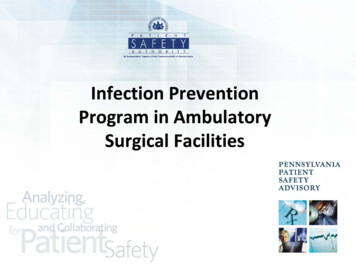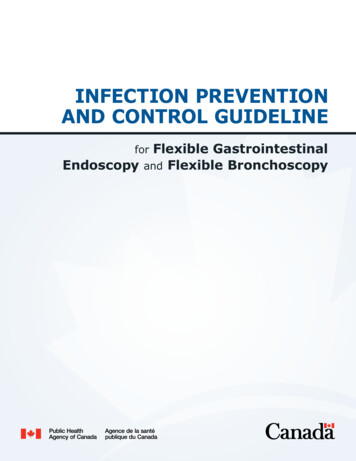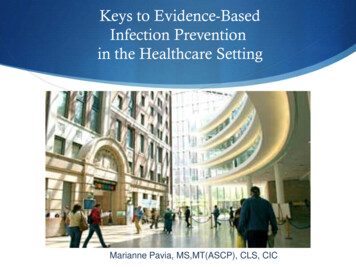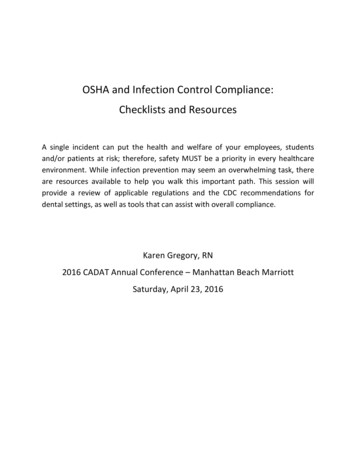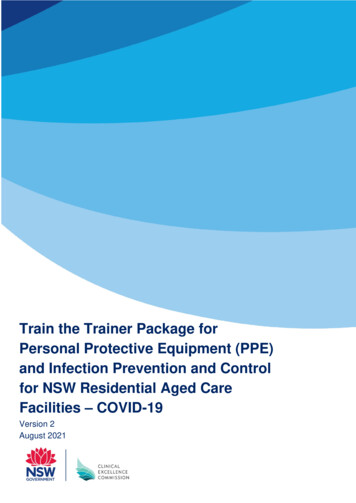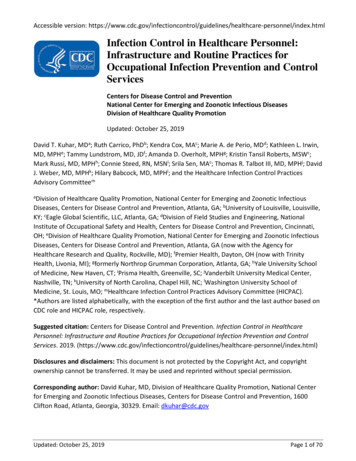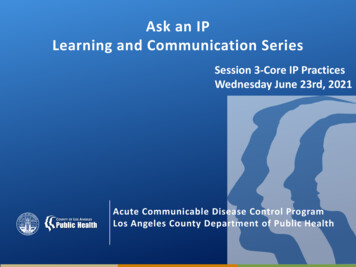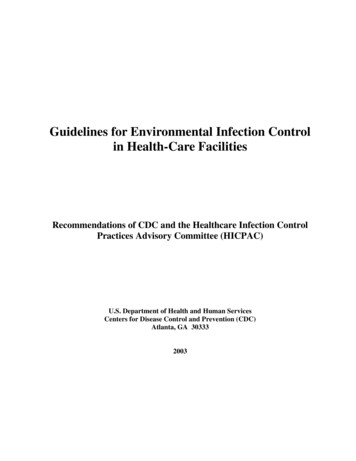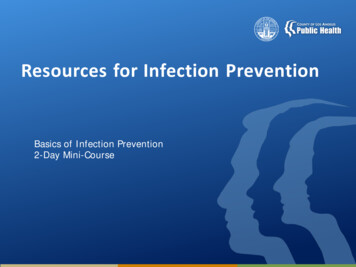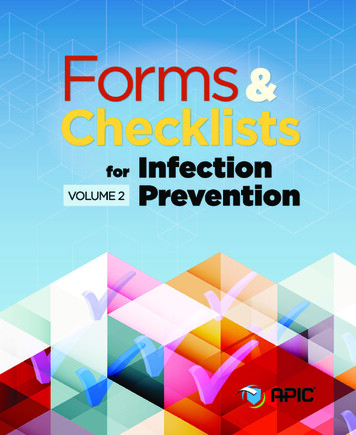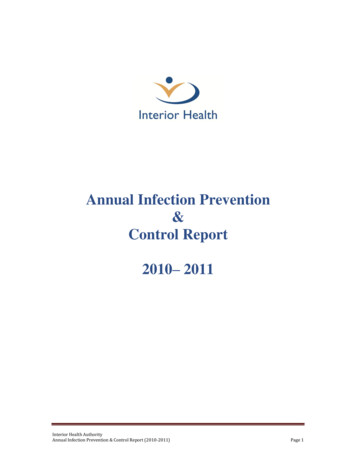
Transcription
Annual Infection Prevention&Control Report2010– 2011Interior Health AuthorityAnnual Infection Prevention & Control Report (2010-2011)Page 1
Table of ContentsTABLE OF CONTENTS . 2EXECUTIVE SUMMARY . 3INTRODUCTION . 6HEALTH CARE ASSOCIATED INFECTION (HAI) INDICATORS . 11CLOSTRIDIUM DIFFICILE INFECTIONS (CDI) INCIDENCE RATE. 13METHICILLIN-RESISTANT STAPHYLOCOCCUS AUREUS (MRSA) INCIDENCERATE. 15VANCOMYCIN-RESISTANT ENTEROCOCCI (VRE) INCIDENCE RATE . 17SURGICAL SITE INFECTION (SSI) INCIDENCE RATE . 19VENTILATOR ASSOCIATED PNEUMONIA (VAP) INCIDENCE RATE . 21OUTBREAKS . 23EDUCATION . 24PROJECTS & INITIATIVES . 25TERMINOLOGY & ABBREVIATIONS . 28Interior Health AuthorityAnnual Infection Prevention & Control Report (2010-2011)Page 2
Executive SummaryIn order to provide a safe environment for patients, staff and visitors the Interior HealthInfection Prevention and Control (IPAC) Program has three principle goals in preventinginfectious agents from spreading within the healthcare environment: Protect the patient, healthcare provider, visitors and others in the healthcareenvironment. Follow established guidelines and protocols to improve our current infectionrates. Accomplish these goals in a cost-effective manner whenever possible.SURVEILLANCE Expanded the residential surveillance processes to include all Interior Healthsites. Healthcare Associated Infections (HAI) Residential indicators:o Lower Respiratory Tract Infection (LRI)o Skin & Soft Tissue Infection (SSTI)o Clostridium difficile Infection (CDI)o Catheter Associated Urinary Tract Infection (CAUTIs) HAI Acute indicators:o CDI, Surgical Site Infection (SSI)o Antibiotic Resistant Organisms (AROs)o Ventilator Associated Pneumonias (VAPs)o Central Line Infections (CLIs) Determined Interior Health Hand Hygiene Initiative (IH HHI) benchmarks. Ongoing development of Insight Reports for data analysis and reporting.EDUCATION Ongoing development of educational tools for Infection Control Practitioners. Initiated the IPAC Link Nurse program at Royal Inland Hospital, providing theinaugural education session for 20 participants. Hand Hygiene Program now includes „Your Four Moments‟. Ongoing educationis provided to all healthcare providers. Two educational face to face meetings were provided:o Positive Deviance – Positive deviance tools were used to identify IPACprogram prioritieso Surveillanceo Dr. Blondel-Hill presented on ARO‟sInterior Health AuthorityAnnual Infection Prevention & Control Report (2010-2011)Page 3
ACHIEVEMENTS Presented Hand Hygiene Poster at Community & Hospital Infection ControlAssociation-Canada (CHICA-Canada) annual conference. A major project was completed. The IPAC Manual was completely updated withstandardized formatting and links to include external references. Dr. Edith Blondel-Hill, Medical Director, Infection Prevention & Control receivedthe following awards:o The Interior Health (IH) Award of Excellence for her contribution to theQuality Work & Service Recognition Program, which is meant to helppromote a workplace climate of respect, recognition, and health byrecognizing the outstanding work of Interior Health‟s staff, managers,leaders, volunteers and physicians.o A Healthcare Hero (Interior Health) Gold Apple for being a driving forcebehind the national Do Bugs Need Drugs campaign for antimicrobialstewardship and handwashing and the Bugs and Drugs antimicrobialreference guide for Canadian clinicians. Through her leadership, theseprograms have reached millions of Canadians who have learned aboutthe inappropriate use of antibiotics and the importance of regularhandwashing.o British Columbia Medical Association (BCMA) Award of ExcellenceInterior Health AuthorityAnnual Infection Prevention & Control Report (2010-2011)Page 4
Based on this year‟s report, the key priorities for next year will be:Priority 1:Priority 2:Developing &implementing anew applicationfor electronicHAI surveillanceprocesses. AnEpidemiologistwill be recruitedto support theprogram.Ensuring HandHygienemeets theexpectations ofthe AuditorGeneral and theMinistry ofHealth. AProject Leaderwill be recruitedto support theprogram.Interior Health AuthorityAnnual Infection Prevention & Control Report (2010-2011)Priority 3:Priority 4:Reviewingauditingprocesses toincludeappropriatefollow-up toimproveoutcomes andensureimplementationof best practice.Developing theIPAC Link NurseProgram forimplementationwith a phased inapproach acrossInterior Health.Page 5
IntroductionINFECTION PREVENTION AND CONTROL PROGRAMInfection Prevention & Control is a corporate program with a Corporate Director and aMedical Director under the administrative direction of the VP, Medicine/Quality.The overarching goal of Infection Prevention and Control is to prevent infections fromoccurring in patients, residents, clients, visitors, physicians and employees. If, forwhatever reason, an individual with an infection is in a facility or program, the goal ofInfection Prevention and Control is to prevent the infectious agent from spreading toothers.Key improvements to monitoring infection prevention & control practices and improvingsafety for patients/residents/clients have been made. It is our intention to do everythingpossible to reduce the risk of infections.The Infection Monitoring Prevention and Control Team (IMPACT), formerly HealthAuthority Infection Prevention & Control Committee (HAIPCC), will report, via theminutes to Health Authority Medical Advisory Committee (HAMAC), the Senior ExecutiveTeam, and the Board Quality Care Committee. Twice a year, Dr. Blondel-Hill willpresent an in person report to HAMAC.The Senior VP, Medicine/Quality is designated as the SET member responsible for theIMPACT.Infection Prevention and Control crosses sectors, departments, and communities.Infection Prevention and Control liaises across the continuum with other programs suchas Public Health in regards to communicable disease and outbreak management.For this reason there is an extensive network of committees responsible for InfectionPrevention & Control. For purposes of practice, the IPAC Practice Committee providesrecommendations through the Infection Prevention & Control Corporate Director to theIMPACT. For purposes of communication and quality, minutes from the fifteen sites andcommunity Infection Prevention & Control committees are reviewed by the CorporateDirector and issues are taken forward to IMPACT as required.Interior Health AuthorityAnnual Infection Prevention & Control Report (2010-2011)Page 6
Interior Health AuthorityAnnual Infection Control Report (201)Page 7
ACKNOWLEDGEMENTSInfection Prevention & Control would like to thank IH Medical Microbiology departmentsDr. Dwight Ferris, Infectious Disease PhysicianIH Medical Health OfficersContact InformationJanice de Heer, Corporate Director,Infection Prevention & ControlTelephone: r. Edith Blondel-HillPhysician Lead, Infection Prevention& ControlTelephone: 250-862-4300x7257Email: Edith.BlondelHill@interiorhealth.caNicki Gill, Infection Prevention &Control, EducatorTelephone: 250-870-4635Email: Nicki.Gill@interiorhealth.caConnie Bergen, AdministrativeAssistant, Infection Prevention &ControlTelephone: nterior Health AuthorityAnnual Infection Control Report (201)Page 8
INFECTION CONTROL PRACTITIONERSContact ListPractitionerArea of ResponsibilityOffice NumberCell/Pager- B Bergen, ConnieAdministrative Assistant toJ. de Heer250-870-5843QuickDial 8-100-5843Fax Blackburn, MissyKelowna General Hospital250-862-4300Ext 3369QuickDial 8-100-3369Cell 250-808-2132Fax 250-862-4187250-314-2693QuickDial 8-200-2693Cell 250-318-3097Fax 250-314-2761Corporate Director, InfectionPrevention & Control250-870-4771QuickDial 8-100-4771Cell 250-864-2866Fax 250-870-5802Acute/ Residential 100 Mile House, WilliamsLake, Alexis Creek, Lytton,Lillooet, & Ashcroft250-302-3214QuickDial 8-202-3214Cell 250-267-1839Fax 250-302-3288Penticton Regional Hospital,South Okanagan GeneralHospital and SummerlandHealth Centre250-492-4000L. 2325QuickDial 8-102-2325Cell 250-488-6939Acute/Residential - Fernie,Elkford Invermere, Golden,Creston & Sparwood250-417-6177QuickDial 8-400-6177Cell ection Prevention &Control/Educator250-870-4635QicklDial 8-100-4635Cell 778-214-0449Fax 250-870-5802Lavoie, EileenVernon Jubilee Hospital250-558-1376QuickDial 8-104-1376Cell 250-558-8238Fax 250-558-1239Acute/ Residential –Cranbrook & Kimberley250-489-6421QuickDial 8-400-6421Cell caRoyal Inland Hospital &Hillside Centre250-314-2100L. 3398QuickDial 8-200-3398Cell 250-318-0345Fax 250-314-2761Lutz, WendyKelowna General Hospital250-862-4314QuickDial 8-100-4314Cell 250-215-0714Fax ca- C Cosgrove-Swan, aRoyal Inland Hospital &Hillside Centre- D de Heer, -Hunt, can, Bonnymailto:bonny.duncan@interiorhealth.ca- G Gawletz, Nancymailto:nancy.gawletz@interiorhealth.caGill, Nicki- L email eileen.lavoie@interiorhealth.caLehman, , Kimmailto:wendy.lutz@interiorhealth.caInterior Health AuthorityAnnual Infection Prevention & Control Report (2010-2011)Page 9
PractitionerArea of ResponsibilityOffice NumberCell/Pager- M McLean Young, MaureenAcute/Residential - Merritt &Residential - Kamloops250-554-2323L.2530Cell 250-318-3715Fax Residential - CentralOkanagan250-862-4300Ext 2443QuickDial 8-100-2443Cell 250-826-3154Fax 250-862-4436Miller, MegKelowna General Hospital250-862-4474QuickDial 8-100-4474Cell 250-808-2942Fax 250-862-4187Residential - CentralOkanagan250-862-4031QuickDial 8-100-4031Cell 250-718-5061Fax 250-862-4436Acute/Residential - Nelson,Kaslo, Nakusp & NewDenver250-354-2375Cell 250-551-2225Fax 250-354-2349250- 503-3704QuickDial 8-104-3704Cell 250-308-9818Fax 250-558-1239250-833-3636L.2259QuickDial 8-222-2259Cell 250-517-0801250-492-4000L. 2324QuickDial 8-102-2324Cell 250-809-8811250-368-3311L.2354QuickDial 8-300-2354Cell 250-231-2227Fax alth.caMcLure, Lorenamailto:meg.miller@interiorhealth.ca- N Neil, Andreamailto:andrea.neil@interiorhealth.caNicol, Evelynmailto:evelyn.nicol@interiorhealth.ca- P Pyett, Joymailto:joy.pyett@interiorhealth.caResidential & Constructionissues for North Okanagan- R Reiswig, / Residential Revelstoke, Salmon Arm,Chase, and Clearwater- S Schwartz, ial - SouthOkanagan & PrincetonGeneral Hospital- T Tench, esidential – Trail ,Castlegar & Grand ForksNote: If you are within the same community do not use the QuickDial option.Interior Health AuthorityAnnual Infection Prevention & Control Report (2010-2011)Page 10
Health Care Associated Infection (HAI) IndicatorsHAND HYGIENE COMPLIANCETrend TargetActual To increase hand hygienecompliance and reduce HAIs68%The Interior Health Hand Hygiene Initiative‟s goal to increase hand hygiene complianceand reduce health care associated infections continues to be the focus of this program.The most recent 2010 initiative focused on hand hygiene compliance in EmergencyDepartments throughout the health authority. Emergency Departments (ED) wereselected based on their low compliance rates in a previous audit. The same audit tooland methodology were employed as in previous audits. The facilities included were twotertiary sites, 2 regional sites and 2 community sites.The pre audit hand hygiene (HH) compliance rate in ED averaged 59% and increased to68% by the end of the 4 month implementation. Further audits were not completed due tothe proposed Provincial Program being implemented across all health authorities. improving; at least 4 consecutive data points moving towards target deteriorating; at least 4 consecutivedata points moving away from target steady; fewer than 4 consecutive data points moving in either directionInterior Health AuthorityAnnual Infection Prevention & Control Report (2010-2011)Page 11
Healthcare workers audited were categorized as follows: Nursing - registered nurses, licensed practical nurses, health care aids andnursing students Medical - physicians and medical students Clinical Support Staff - physiotherapists, occupational therapists, respiratorytherapists & radiology technologists Support Services - client transporters, dieticians, food services, housekeepingand maintenance staffThe next phase of the IH HHI will be based on the requirements of the Provincial HandHygiene Working Group (PHHWG).Interior Health AuthorityAnnual Infection Prevention & Control Report (2010-2011)Page 12
Clostridium difficile Infections (CDI) IncidenceRateTREND*TargetActual Zero0 – 15.90 cases per 10,000patient daysWhat is being measured?The incidence rate of Clostridium difficile infection (CDI) per 10,000 patient days, which isthe number of new cases of CDI acquired by patients as a result of their stay in ahospital, divided by the total number of inpatient days over a specified time frame.PICNet Definition:A diagnosis of CDI applies to a person with: Acute onset of diarrhea ( 3 loose stools within a 24 hr period) without anotheretiology (loose stool is defined as that which takes the shape of the container thatholds it).And one or more of the following: Laboratory confirmation (positive toxin or culture with evidence of toxin production)OR Diagnosis of typical pseudo-membranes on sigmoidoscopy or colonoscopy orhistological/pathological diagnosis of CDI.OR Diagnosis of toxic megacolon.Source:Quality Management Enterprise – QME (computerized surveillance program).Target:Interior Health‟s annual target is zero.Benchmark & Comparators:IH Benchmark: 6 per 10,000 patient days.PICNET benchmark:http://www.picnet.ca/uploads/files/CDI Surveillance Report FY2010 11%20final.pdfInterior Health AuthorityAnnual Infection Prevention & Control Report (2010-2011)Page 13
Trend:The rates of CDI are Increasing at 50% of the sites whose rates are above the IHbenchmark of 6 cases per 10,000 patient days. improving; at least 4 consecutive data points moving towards target deteriorating; at least 4 consecutive datapoints moving away from target steady; fewer than 4 consecutive data points moving in either directionExplanation: Four small rural sites had increased rates of CDI – with less patient days, ongoingsingle cases significantly increases the incidence rate of CDI. One tertiary site had steady rates above the benchmark.Over the past year the following actions have been taken to reduce the incidenceof CDI: Review of antibiotic utilization Review patient placemen. Review of cleaning of the patient care environment Pre-printed physician orders for the appropriate treatment of CDI available acrossIH Outbreak Management Guidelines for CDI are now included in the IPAC ManualInterior Health AuthorityAnnual Infection Prevention & Control Report (2010-2011)Page 14
Methicillin-resistant Staphylococcus aureus(MRSA) Incidence RateTrend TargetActual Zero0 – 14.28 cases/10,000 patientdaysWhat is being measured?The incidence rate of Methicillin-resistant Staphylococcus aureus (MRSA) cases per10,000 patient days, which is the number of new cases of MRSA acquired by patients asa result of their stay in hospital or previous contact with a healthcare facility or program,divided by the total number of inpatient days over a specified time frame.Definition (currently being developed by PICNet):An MRSA case is defined as meeting ALL of the following criteria: Not previously positive for MRSA ANDo Current hospitalization 3 calendar days (unless an indwelling medicaldevice in place) ORo Prior contact with any Health Care facility including surgery, dialysis andLTC admissions in previous 12 months ORo Newborns if mother not known to be a case on admission or suspected tobe colonizedo Does not include Emergency Room and Ambulatory Care outpatient visito Data collected for acute inpatients only as of September 17, 2010Source:Quality Management Enterprise – QME (computerized surveillance program).Target:Interior Health‟s annual target is zero.Benchmark & Comparators:IH Benchmark: 5.6 per 10,000 patient days.Trend:The MRSA rates are decreasing at most sites and are below the benchmark of 5.6. improving; at least 4 consecutive data points moving towards target deteriorating; at least 4 consecutivedata points moving away from target steady; fewer than 4 consecutive data points moving in either directionInterior Health AuthorityAnnual Infection Prevention & Control Report (2010-2011)Page 15
ExplanationsOne rural site and one regional site identified increasing trends of MRSA cases. This maybe due to increasing amounts of MRSA circulating in the Community.Actions over the past year: Review of admission screening processes for MRSA to ensure these are beingfollowed appropriately Review of appropriate use of Contact Precautions with patients with MRSA Reinforce appropriate staff hand hygiene practices Review the process for patient care environment cleaning.Interior Health AuthorityAnnual Infection Prevention & Control Report (2010-2011)Page 16
Vancomycin-Resistant Enterococci (VRE) IncidenceRateTrend TargetActual Zero0 – 10.64 cases/10,000 patientdaysWhat is being measured?The incidence rate of Vancomycin-Resistant Enterococci (VRE) per 10,000 patient days,which is the number of new cases of VRE acquired by patients as a result of their stay inhospital or previous contact with a healthcare facility or program, divided by the totalnumber of inpatient days over a specified time frame.Definition:A VRE case is defined as meeting ALL of the following criteria: Not previously positive for VRE ANDo Current hospitalization 3 calendar days (unless an indwelling medicaldevice in place) ORo Prior contact with any Health Care facility including surgery, dialysis and LTCadmissions in previous 12 months ORo Newborns if mother not known to be a case on admission or suspected to becolonizedo Does not include Emergency Room and Ambulatory Care outpatient visito Data collected for acute inpatients only as of September 17, 2010Source:Quality Management Enterprise – QME (computerized surveillance program).Target:Interior Health‟s annual target is zero.Benchmark & Comparators:IH Benchmark: 1.1 per 10,000 patient days.Trend:Significant increases were identified throughout the last half of the year in most sites thatexceeded the benchmark of 1.1 cases per 10,000 patient days. improving; at least 4 consecutive data points moving towards target deteriorating; at least 4 consecutivedata points moving away from target steady; fewer than 4 consecutive data points moving in either directionInterior Health AuthorityAnnual Infection Control Report (2009-2010)Page 17
ExplanationsThis increase correlates with additional screening for VRE of stool samples submitted forClostridium difficile testing.Point prevalence studies were implemented during an outbreak at Kelowna GeneralHospital (KGH) which significantly increased the rate of VRE cases.Actions over the past year: Outbreak Management Team established at KGH Review of admission screening processes for VRE to ensure these are beingfollowed appropriately Review of appropriate use of Contact Precautions with patients with VRE Reinforce appropriate staff hand hygiene practices Review cleaning of the patient toileting facilities, including commodes Implementation of collaborative cleaning processes with nursing andhousekeeping staff Reinforce reducing clutter in the patient care areasInterior Health AuthorityAnnual Infection Prevention & Control Report (2010-2011)Page 18
Surgical Site Infection (SSI) Incidence RateTrend TargetActual ZeroClean SSI rate 0-1.43%Clean Contaminated SSI rate0 – 1.59%What is being measured?The overall incidence rate of Clean SSIs and Clean Contaminated SSIs.Definitions:(Reference National Healthcare Safety Network (NHSN) 2008An infection in the area affected by a surgery within 30 days of the procedure, or within365 days if an implant is in place and infection related to the operative procedure.Surgeries under surveillance do not include those without an incision or surgeriesperformed in the Ambulatory Care setting.Clean Wounds (Class I) – uninfected operative wound in which no inflammation isencountered, involve access only to the sterile body sites and carry the lowest risk (e.g.less than 5%) of surgical site infection.Clean-Contaminated Wounds (Class II) – those in which respiratory, gastrointestinal,urinary, or genital tracts were involved under controlled conditions and without unusualcontamination. A minor break in surgical sterile technique in an otherwise cleanprocedure would fit into this class.Source:Quality Management Enterprise – QME (computerized surveillance program).Target:Interior Health‟s annual target is zero.Benchmark & Comparators:IH Benchmark: less than 1% for clean and clean contaminated surgeries.Trend:In most sites the Clean SSI rate and Clean Contaminated SSI rates are consistently low.Four sites are marginally above the IH benchmark of 1%. improving; at least 4 consecutive data points moving towards target deteriorating; at least 4 consecutivedata points moving away from target steady; fewer than 4 consecutive data points moving in either directionInterior Health AuthorityAnnual Infection Prevention & Control Report (2010-2011)Page 19
Explanation: Smaller rural sites performing surgeries do not have computerized technology forSSI surveillance data collection and analysis.Due to the small number of surgeries in some sites one infection will significantlyincrease the incidence rates.Procedures done in Ambulatory Care are not standardized throughout IH. Thismay result in inconsistencies related to “excluded procedures”.Actions taken over the past year: As increasing SSI trends are identified, assessments of processes and practicesrelated to the surgical procedure are completed. Recommendations are thanmade to Surgical Services to improve outcomes.Interior Health AuthorityAnnual Infection Prevention & Control Report (2010-2011)Page 20
Ventilator Associated Pneumonia (VAP) IncidenceRateTrend TargetActual Zero0 – 11.30 VAPs/1000ventilator daysWhat is being measured?The incidence rate of Ventilator Associated Pneumonias per 1,000 ventilator days, whichis the number of new cases of VAP acquired by patients as a result of their stay in ICUand being on a ventilator divided by the total number of ventilator days over a specifiedtime frame.Definition:A VAP case is defined as meeting ALL of the following criteria: Clinical presentation meets criteria for Pneumonia, including x-ray confirmation- there is no minimum time for a patient to be on a ventilator. Pneumonia identified by using a combination of the following criteria:o Radiologic - two or more serial chest x-rays with new or progressive &persistent infiltrate, consolidation, cavitation (only one x-ray if no lung/heartdisease).o Clinical S&S- breath sounds, fever, altered mental status, sputum, cough,increased respiratory rate or oxygen needs.o Lab - sputum culture, elevated WBC.Source:Quality Management Enterprise – QME (computerized surveillance program).Target:Interior Health‟s annual target is zero.Benchmark & Comparators:IH Benchmark: 5 per 1,000 ventilator days.NHSNCDC National Healthcare Safety HSNReport.pdf improving; at least 4 consecutive data points moving towards target deteriorating; at least 4 consecutivedata points moving away from target steady; fewer than 4 consecutive data points moving in either directionInterior Health AuthorityAnnual Infection Prevention & Control Report (2010-2011)Page 21
Trend:Kootenay Boundary Regional Hospital has decreased their rates by 50% over the pastyear.Explanation: Smaller sites have significantly less ventilator days, so one VAP case cansignificantly increase the overall incidence rate.Actions over the past year: Each VAP case is investigated to determine potential risk factors andrecommendations made to staff to improve outcomes.Interior Health AuthorityAnnual Infection Prevention & Control Report (2010-2011)Page 22
OutbreaksInfection Prevention & Control reports all outbreaks to Interior Health‟s CommunicableDisease Unit where statistics are generated and reported to British Columbia Centre forDisease Control (BCCDC).Ongoing surveillance continues for the following outbreaks: Tuberculosis Respiratory Illness including influenza Gastrointestinal Illness including NorovirusAdditional information on IH Outbreaks can be accessed by viewing the CommunicableDisease Annual Report 2010 located on the CD website under Activity 20v2.0 %20dmc final.pdfInterior Health AuthorityAnnual Infection Prevention & Control Report (2010-2011)Page 23
EducationOngoing education provided to healthcare workers includes review of: Routine Practices (including hand hygiene) Additional Precautions Specific Diseases (as incidents arise) Outbreak Management IPAC Manual UpdatesInfection Prevention & Control was involved in the development of presentationsincluding Cleaning Patient Equipment, Housekeeping & Infection Control, Outbreaks forFrontline Staff, Measles Mumps Rubella and Influenza Staff Education.Developed presentations for two face-to-face IPAC meeting days.Workshop prepared and presented for the initial education day for IPAC Link Nurse.In addition Infection Control Practitioners (ICPs) attended various training sessionsincluding the following:TypeDescriptionParticipantsEstimated TimeTeleclassesWebber trainingAvailable to all IHICPsOccur weeklyConferenceCHICA 2010 AnnualConference inVancouver”Orientation/training ofICPsAttended by 6 ICPs5 days perparticipant1 new ICP(Residential)1 Acute with previousresidential experience1 ICP10 days perparticipantOn site and byphone, computerand Live MeetingsEducationWorkshopEducationWorkshopQuality ConferenceCertification ExamCanadian PatientSafety Institute (CPSI)Conference/Workshopon Hand Hygiene inVancouverCanadian Nosocomial Attended by 2 ICPsInfection SurveillanceProgram (CNISP) inOttawaUnleashing CreativeAttended by 7 ICPsAction atthe Front Line inKelownaCertification in1 ICPInfection ControlInterior Health AuthorityAnnual Infection Prevention & Control Report (2010-2011)1 day2 days perparticipant2 days perparticipantChallenge exam(unable todetermine)Page 24
Projects & Initiatives(Infection Prevention & Control) IP&C Manual – RevisionDescription: The entire manual was reformatted and standardized.o Links have been added to enable the user to movethroughout the manual with ease.The revised IH Infection Prevention & Control Manual is nowavailable and can be found on the InsideNet at Clinical Resourcesor Policies & Procedures or Quality & Patient Safety and on theInternet d 732&terms infection control manualAll staff are expected to use the “on line” copy of the manual whichcontains the most up to date information.There will be one “hard copy” of the manual available at eachAcute and Residential site in the event that the electronic copycannot be accessed.Staff education provided on accessing the manual on line.Challenges identified:o Technology not always readily available to staff at point of use.o Not everyone is computer literate.Status:CompleteOrganizationalImpact: Online version is sustainable, lean and financially responsible.This is a more efficient process that has shown the way to greateraccuracy and relevancy because it allows for real-time updates.Processes are standardized across the continuum of care andacross all IH sites and programs.Facilitates collaboration with non IH sites to ensureimplementation of standardized processes.Contains the most up to date information and is readily available.Interior Health AuthorityAnnual Infection Control Report (2009-2010)Page 25
Construction ( 2 Large scale capital projects, one in Vernon andone in Kelowna plus the clinical support building in Kelowna)Description: Two ICPs have been designated as the main point of contact forconstruction information and development of standardizedprocesses.Developing a condensed version of the draft (Canadian StandardsAssociation) CSA Z8000 Canadian Healthcare Facilitiesdocument specific to IH Infection Prevention & dization of IP&C pr
Lehman, Lynden mailto:lynden.lehman@interiorhealth.ca Acute/ Residential - Cranbrook & Kimberley 250-489-6421 QuickDial 8-400-6421 Cell 250-919-7736 Leslie, Kim mailto:kimberly.leslie@interiorhealth.ca Royal Inland Hospital & Hillside Centre 250-314-2100 L. 3398 QuickDial 8-200-3398 Cell 250-318-0345 Fax 250-314-2761 Lutz, Wendy
